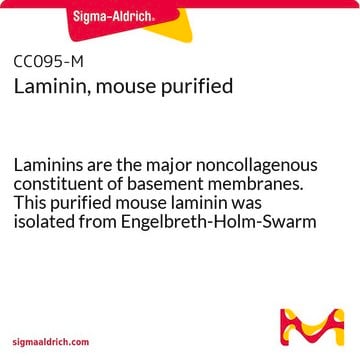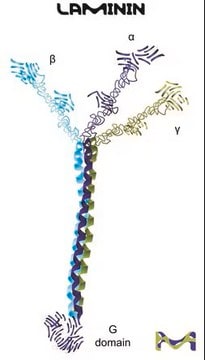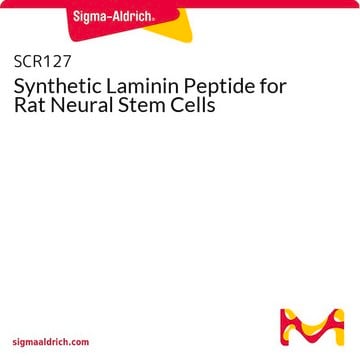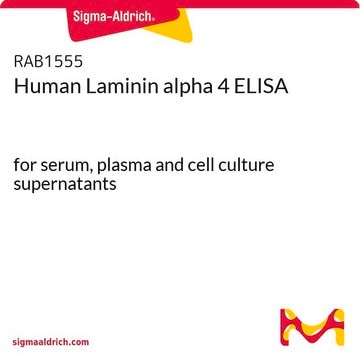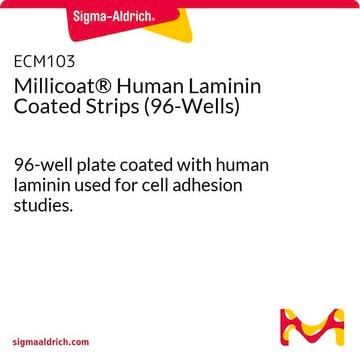In undiluted form or diluted to working concentration, this material may be stored at -20°C in aliquots up to the recommended retest date for the specific lot. This data is published in the Certificate of Analysis. Avoid repeated freeze/thaw cycles. The solution may be transferred to smaller vials in working volumes for long-term storage. Plastic vials are recommended as this protein tends to adhere to glass. Please see the link below to access the product datasheet for additional details:
https://www.sigmaaldrich.com/deepweb/assets/sigmaaldrich/product/documents/409/686/l2020pis-ms.pdf
L2020
Mouse Laminin
from Engelbreth-Holm-Swarm murine sarcoma basement membrane, 0.2 μm filtered, liquid, 1-2 mg/mL, suitable for cell culture
Synonym(s):
Laminin
Select a Size
Select a Size
About This Item
Recommended Products
Product Name
Laminin from Engelbreth-Holm-Swarm murine sarcoma basement membrane, 1-2 mg/mL in Tris-buffered saline, 0.2 μm filtered, BioReagent, suitable for cell culture
biological source
mouse (Engelbreth-Holm-Swarm mouse sarcoma basement membrane)
Quality Level
product line
BioReagent
form
aqueous solution
mol wt
A subunit 400 kDa
B1 subunit 210 kDa
B2 subunit 200 kDa
packaging
pkg of 1 mg
concentration
1-2 mg/mL in Tris-buffered saline
technique(s)
cell culture | mammalian: suitable
surface coverage
1‑2 μg/cm2
impurities
Microbial Contamination, passes test
NCBI accession no.
Binding Specificity
Peptide Source: Collagen
shipped in
dry ice
storage temp.
−20°C
Gene Information
mouse ... Lama1(16772) , Lamb1(16777) , Lamc1(226519) , Lamc2(16782)
Looking for similar products? Visit Product Comparison Guide
General description
Application
Biochem/physiol Actions
Components
Caution
Preparation Note
Not finding the right product?
Try our Product Selector Tool.
related product
Storage Class Code
11 - Combustible Solids
WGK
WGK 3
Flash Point(F)
Not applicable
Flash Point(C)
Not applicable
Personal Protective Equipment
Choose from one of the most recent versions:
Certificates of Analysis (COA)
Don't see the Right Version?
If you require a particular version, you can look up a specific certificate by the Lot or Batch number.
Already Own This Product?
Find documentation for the products that you have recently purchased in the Document Library.
Customers Also Viewed
Articles
The extracellular matrix (ECM) and its attachment factor components are discussed in this article in relation to their function in structural biology and their availability for in vitro applications.
The extracellular matrix (ECM) is secreted by cells and surrounds them in tissues.
Frequently asked questions about neural stem cells including NSC derivation, expansion and differentiation.
Derivation and characterization of functional human neural stem cell derived oligodendrocyte progenitor cells (OPCs) that efficiently myelinate primary neurons in culture.
Protocols
Coating surfaces with laminin for culturing cells requires specific conditions for optimal results. Protocols for coating coverslips to culture neurospheres and general cell culture are included.
A stem cell culture protocol to generate 3D NSC models of Alzheimer’s disease using ReNcell human neural stem cell lines.
Step-by-step culture protocols for neural stem cell culture including NSC isolation, expansion, differentiation and characterization.
-
How long can stocks be frozen at -20C for?
1 answer-
Helpful?
-
-
How will the product L2020 shipped? Will it be shipped in room temperature, on ice, or on dry ice?
1 answer-
The product L2020 will be shipped using dry ice. Upon receipt, it should be stored at -20 degrees Celsius.
Helpful?
-
-
How is this laminin concentration determined? (by which method?) I tried to measure the concentration of this product by ELISA, and the results always came out half of what is written on the vial.. what is the protein purity?
1 answer-
Laminin concentration is 1.0 - 2.0 mg protein/ml. The protein content is determined by Lowry method. Please refer the attached document for more details. https://www.sigmaaldrich.com/specification-sheets/131/942/L2020-1MG_________SIGMA____.pdf
Helpful?
-
-
What is the purity of Laminin, Product L2020?
1 answer-
We do not determine a purity of this product. An SDS PAGE gel is run and the pattern (3 bands) is comparable to past lots.
Helpful?
-
-
What type of laminin is Product L2020?
1 answer-
In the nomenclature system by Burgeson, this is Laminin 1. The laminins were numbered with Arabic numerals in the order discovered. The previous A, B1, and B2 chains, and their isoforms are listed by the Greek letters, for alpha, beta, and gamma, respectively, followed by an Arabic numeral to identify the isoforms. For example, the first laminin identified from the Engelbreth-Holm-Swarm tumor (EHS) was designated laminin-1 with the chain composition α-1/β-1/γ-1. The genes for these 3 chains are LAMA1, LAMB1, and LAMC1. Reference: Burgeson, R.E., et al., A new nomenclature for the laminins. Matrix Biol., 14, 209-211 (1994).
Helpful?
-
-
What is the protein concentration of the solution of Product L2020, Laminin?
1 answer-
The protein specification for L2020 is 1.0 to 2.0 mg/mL. The exact value can be found on the lot-specific Certificate of Analysis, which can be downloaded from our website.
Helpful?
-
-
Can I coat Laminin, Product L2020, on top of poly-L-lysine for better adherence?
1 answer-
When coating coverslips or slides for use with neural stem cells (neurospheres), the following procedure is recommended. Precoat the coverslips with poly-L-lysine (Product No. P5899) at 100 μg/mL. This is incubated for 30 minutes or more at room temperature. The coverslips are then washed with sterile water and allowed to dry. The poly-lysine coated coverslips can be stored at room temperature until ready to use (up to ~1 month). Coverslips are then coated with 30 - 50 μL of warmed laminin, which is at a concentration of 50 μg/mL. Incubate at 37°C for 30 minutes. Remove the laminin, and wash with DME (50 μL) twice. Cells are then added to the coverslips.
Helpful?
-
-
How can I store solutions of Laminin, Product L2020?
1 answer-
The product has a recommended storage temperature of -20°C. Please note, the product needs to be thawed slowly at 2-8°C. If the product has been warmed up at room temperature and it gels, it cannot be reactivated for use. We recommend storage at 2-8°C for up to one week. For longer storage, the product needs to be frozen at -20°C in single-use aliquots.
Helpful?
-
-
What is the Department of Transportation shipping information for this product?
1 answer-
Transportation information can be found in Section 14 of the product's (M)SDS.To access the shipping information for this material, use the link on the product detail page for the product.
Helpful?
-
Active Filters
Our team of scientists has experience in all areas of research including Life Science, Material Science, Chemical Synthesis, Chromatography, Analytical and many others.
Contact Technical Service

